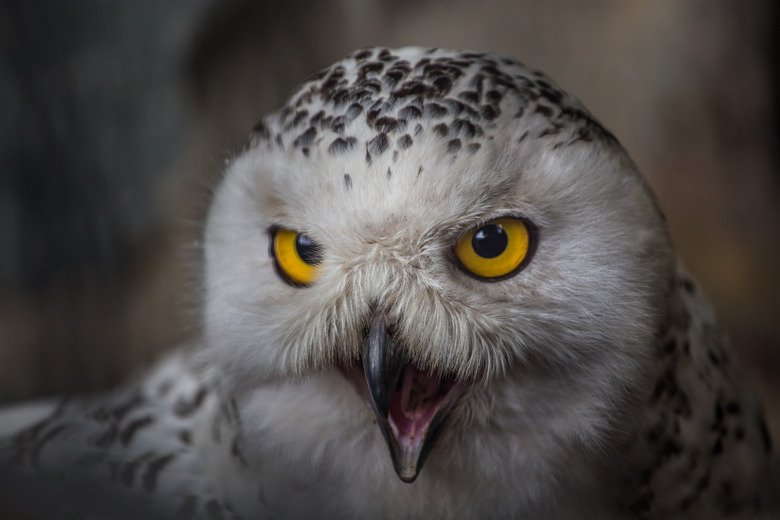Where Does A Snowy Owl Fit In A Food Web?
The snowy owl (Bubo scandiacus) inspires awe due to its great size and striking white feathers.
As is typical for owls, the snowy owl is considered a predator. The prey species that make up the snowy owl food chain vary depending on the time of year and abundance.
TL;DR (Too Long; Didn't Read)
The snowy owl plays the role of predator in its food web. The prey of the snowy owl varies according to season and availability.
Snowy Owl Facts
Snowy Owl Facts
Snowy owls reside primarily in Arctic regions. Snowy owls live in various landscapes, including tundra, fields and prairies, marshlands, coastal areas and occasionally even large airports.
At times they travel outside the far north during winter. This happens roughly every four years, and the phenomenon is called an irruption.
In winter, the snowy owl's plumage is a highly reflective white. This helps the owl blend in the snowy winter landscape of the Arctic, making it harder for prey to see. Females possess some dark bars in their feathers.
The owls' feet are covered with slipper-like batches of feathers to keep them insulated. All these feathers make the owls comparatively heavy birds!
Their curved beaks bear sensory bristles. They use their sharp beaks and impressive talons to capture and consume prey.
Because they dwell in cold regions, snowy owls carry thick fat on their bodies to help them survive. This fat layer helps them go without food for long periods of time, if needed. This is especially crucial since many of the prey species in the snowy owl diet are seasonal.
The snowy owl is a day hunter, at times preferring dusk. But given the 24-hour darkness of the winter Arctic night, snowy owls do hunt at night when they need to.
Snowy owls breed in late spring to summer and are typically monogamous. Females lay clutches of three to 11 eggs. There tend to be more eggs laid in times of high prey abundance.
The father brings food to the mother, who in turn distributes it to their young. Young snowy owls are fully fledged at about seven weeks of age.
Adult snowy owls display an impressive 4- to 5-foot wingspan. Despite their massive wings, however, snowy owls do spend a fair amount of time walking on their two legs. They sometimes hop and run, and in rare instances they can even swim.
Snowy owls do not congregate in flocks; they can be partially colonial breeders. However, sometimes non-breeding, young bachelor males group together in times when there are high lemming populations. These loose groups are referred to as "bachelor areas."
Snowy Owl Food Web
Snowy Owl Food Web
In the snowy owl food web, the snowy owl plays the role of predator. The snowy owl is a consumer, not a producer, and classifies as a carnivore. The snowy owl primarily captures small mammals but will take other kinds of animals depending on where they live.
The snowy owls have essentially no predators as adults, although their young are sometimes taken as prey. Young owls can be taken by eagles, foxes, wolves and even gulls and ravens. The owl's usual role as predator is essential for a healthy Arctic ecosystem.
Snowy Owl Hunting Methods
Snowy Owl Hunting Methods
The snowy owl uses a number of strategies to search for and capture its prey. One of the more interesting snowy owl facts is that they are not nocturnal in the manner of most owls. Therefore, they rely on their eyesight to help find prey.
Snowy owls walk to inspect prey areas. When they seek prey from the air, they glide until ready to strike. Then they fly low and use one of two methods to capture prey. They can sweep, snatching prey with their feet. Or they can wallop, coming down hard on the prey.
Foods in the Snowy Owl Diet
Foods in the Snowy Owl Diet
A number of foods make up the snowy owl diet, ranging from mammals to birds and fish.
Lemmings typically rank as the preferred choice in the snowy owl diet. Other mammals in the owl diet include voles, mice, rats, hares and ground squirrels.
Birds captured by snowy owls include shorebirds, sea ducks, passerines and occasionally even larger birds like herons and geese.
Once in a while, snowy owls consume the remains of animals caught in traps by humans. They take insects and crustaceans occasionally. Large animals may be scavenged.
Learning about snowy owl facts and the importance of the owl's food web can help conservationists better protect these amazing birds. If you see a snowy owl in the wild, keep a safe and respective distance, and watch their many behaviors.
Cite This Article
MLA
Hermance, Dianne. "Where Does A Snowy Owl Fit In A Food Web?" sciencing.com, https://www.sciencing.com/snowy-owl-fit-food-web-6952910/. 15 November 2019.
APA
Hermance, Dianne. (2019, November 15). Where Does A Snowy Owl Fit In A Food Web?. sciencing.com. Retrieved from https://www.sciencing.com/snowy-owl-fit-food-web-6952910/
Chicago
Hermance, Dianne. Where Does A Snowy Owl Fit In A Food Web? last modified March 24, 2022. https://www.sciencing.com/snowy-owl-fit-food-web-6952910/
